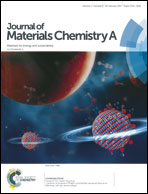Morphogenesis of cement hydrate†
Abstract
As the most widely used synthetic material on the planet, concrete poses a serious societal concern regarding its significant environmental footprint. There is a global urgency to develop innovative strategies to develop greener concrete with improved strength and durability (to do more with less). In this context, reducing cement hydrate porosity via tuning the kinetics and morphology of its building blocks is highly desired but a fundamental challenge. Herein, we propose for the first time a unique pathway involving in situ seed generation and subsequent controlled overgrowth, demonstrating the morphogenesis of cement hydrate ranging from cubic, rhombohedral, dendritic to core–shell-like structures, which are all expressed in a single morphology diagram. Probing the mechanics of individual particles versus their assemblies at larger scales reveals that the low porosity attained by the formation of face-to-face close-packed cubic particles leads to significantly improved mechanics, opening up an entirely new phase space for bottom-up engineering of concrete while curbing its negative environmental impacts.


 Please wait while we load your content...
Please wait while we load your content...